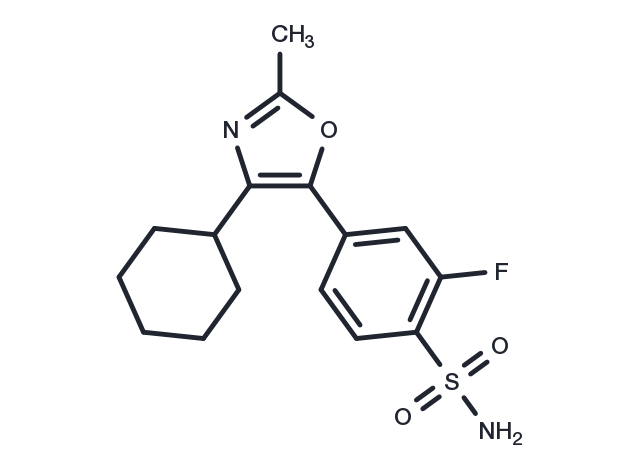Powder: -20°C for 3 years | In solvent: -80°C for 1 year


Tilmacoxib is a highly selective, time-dependent, and irreversible inhibitor of human COX-2 ( IC50: 85 nM in an enzyme assay).

| Pack Size | Availability | Price/USD | Quantity |
|---|---|---|---|
| 25 mg | 6-8 weeks | $ 1,520.00 | |
| 50 mg | 6-8 weeks | $ 1,980.00 | |
| 100 mg | 6-8 weeks | $ 2,500.00 |
| Description | Tilmacoxib is a highly selective, time-dependent, and irreversible inhibitor of human COX-2 ( IC50: 85 nM in an enzyme assay). |
| Targets&IC50 | COX-2(human):85 nM |
| In vitro | Tilmacoxib is less potent at inhibiting calcium ionophore-induced thromboxane B2 production in washed human platelets (COX-1) (IC50=6.21 μM). Tilmacoxib inhibits yeast-expressed human recombinant COX-2 (IC50: 0.085 μM), in an enzyme assay. Tilmacoxib does not inhibit human COX-1 prepared from human platelets at concentrations up to 100 μM. Tilmacoxib diminishes lipopolysaccharide-induced prostaglandin E2 production in human peripheral blood mononuclear cells (COX-2) (IC50=15.1 nM), in a cell-based assay. Tilmacoxib displays highly selective inhibition of human COX-2, and its activity is more selective than that of other COX-2 inhibitors (NS-398 and SC-58635). Human recombinant COX-2 activity is attenuated by Tilmacoxib in a dose-dependent and time-dependent manner[1]. Inhibition of proliferation of gastric epithelial cells by a cyclooxygenase 2 inhibitor, Tilmacoxib (JTE522), is also mediated by a PGE2-independent pathway Combination of Tilmacoxib and Arachidonic acid results in marked retardation of wound healing compared to the control, but Tilmacoxib does not completely suppress the increase in cellular PGE2 content following the addition of arachidonate[2]. |
| In vivo | Administration of Tilmacoxib (10 mg/kg) obviously inhibits ACF formation with a 30% reduction in total ACF/colon (p<0.01). The data on crypt multiplicity display that 10 mg/kg Tilmacoxib significantly decreases the formation of foci containing 1-3 crypts but not foci containing four crypts or more. Administration of the low dose of Tilmacoxib (3 mg/kg) has no inhibitory effects on either the total ACF or crypt multiplicity. From the start of the experiment, a total of 80 male F344 rats are treated with 3 or 10 mg/kg of body weight Tilmacoxib or vehicle by oral gavage five times weekly. One week later, rats receive s.c. injections of saline or 20 mg/kg of body weight DMH once weekly for four successive weeks. At the end of 12 weeks after the start of the experiment, all rats are sacrificed and colons are evaluated for ACF. 10 mg/kg Tilmacoxib significantly suppresses the total ACF/colon. No inhibitory effect is observed in the 3 mg/kg Tilmacoxib treatment group [3]. |
| Synonyms | RWJ57504, JTP19605, JTE522 |
| Molecular Weight | 338.4 |
| Formula | C16H19FN2O3S |
| CAS No. | 180200-68-4 |
Powder: -20°C for 3 years | In solvent: -80°C for 1 year
You can also refer to dose conversion for different animals. More
bottom
Please see Inhibitor Handling Instructions for more frequently ask questions. Topics include: how to prepare stock solutions, how to store products, and cautions on cell-based assays & animal experiments, etc.
Tilmacoxib 180200-68-4 Immunology/Inflammation Neuroscience COX RWJ57504 JTP19605 JTP-19605 JTP 19605 JTE522 RWJ-57504 RWJ 57504 JTE 522 JTE-522 inhibitor inhibit
